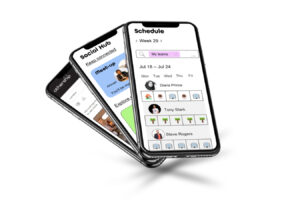Team building alone can be a difficult task for any manager or leader. The new work reality of remote and hybrid teams that can be distributed over several locations and time zones does not make it any easier. It becomes obvious that team culture is more than Wednesday lunches, Friday beers, and ping pong tables. Team culture is about connection not only between the company and its employees but also between individual team members. It is the basis for fruitful collaborations and successful projects. Just because a team does not sit together in the same office at the same time, does not mean that there can’t be a great team culture. Here are our tips on how to build a culture with a remote team!

Communicate goals clearly
In any work setting, communication is key. It is easy to lose track of communication in distributed teams. As the manager, you should always keep an eye on it and ensure that you communicate everything the team needs to know in a clear way. It starts with the goals and expectations. Every team member should know exactly what is expected of him/her and of the others, and what they’re working towards, together as a team.
Be explicit about work policy
In remote and hybrid teams, it is natural that you don’t always see everybody. You can’t look over their shoulder and there is a risk of employees slacking off. Before you can complain about any negative work ethic though, you should ensure that it has been clearly communicated what the team is expected to do. These can be policies like being at their desk and online at certain times, meeting attendance, and work deliverables. Whatever your company’s hybrid working policy, ensure it is clearly communicated and the same rules apply to every team member, including yourself. You won’t be able to build a culture in a remote team if some team members get special treatment.
Dedicate time for team building
Team building has become such a catchphrase, but it is important, and you need it for your team to get to know each other and to grow trust. Team culture also means that they know each other well enough to collaborate, leverage strengths and overcome weaknesses, and know “how the other person thinks”. If there is a chance to do a team-building activity in person, that’s great and if not, there are by now plenty of virtual options. Your job is to ensure that nobody will be excluded. If there is only one team member who can’t be there in person due to distance, make it a virtual one!
Team rituals
If we go back to the original meaning of culture, it usually comes down to the traditions and rituals of a group of people that bond over these activities and feel connected. Why should this be different in business? Team rituals can facilitate stronger bonds. This could be things like a virtual happy hour or a team breakfast. Come up with some fun things to do during this time. Employees should not feel obliged to join, but they should want to join.
Provide opportunities for in-person meetups
This point strongly depends on your hybrid working setup. If employees regularly come to the office, there is an opportunity to meet in person if they want to. If there is no formal office and employees work from anywhere, there could be a few that are in a close location to one another. In this circumstance, you can facilitate for them to meet up by offering coworking memberships or an allowance for day passes or coffee shops to work from. There are hundreds of ways to do hybrid work and there are at least as many opportunities to make it enjoyable for everybody.

If you need some advice on hybrid work solutions, book a call with us and we help you find the best solution for your hybrid team!
Recognition
You clearly communicated the rules and expectations, don’t forget the achievements! Show and tell the team what they’ve achieved together and recognize individual effort. Not only will the team member that you are praising feel appreciated, it also increases trust and encourages everybody to go the extra mile. Now that’s a good foundation for a strong team culture!

Photo by krakenimages on Unsplash
Face-to-face time: Ask, listen and act
When you see your team regularly in person, you can pick up on certain things. Does somebody seem distracted? Could there be personal issues? Is a team member getting singled out in meetings? It is a lot harder to notice such situations in remote work settings and that makes it even more important to have dedicated face-to-face time with each team member.
This should be a standing meeting and you should use this time to ask questions and listen to what they say. Be empathetic! Try to really understand what they are telling you in these meetings. In a hybrid work environment where employees regularly come to the office, try and make this an in-person meeting over a coffee or tea. If it is a video call, ensure you both switch your cameras on and can see each other!
Encourage asynchronous communication
Depending on your remote working policy and the team setup, everybody could be in a completely different location and time zone. It might be difficult to find a good time for a team meeting. Asynchronous communication is a great solution for this, and it facilitates referencing what somebody said. Instead of a daily stand-up where everybody must be present, each team member could upload a short video to a shared drive about the things they are working on. Equally, presentations and reports can be recorded and watched when and as often as necessary.
Meeting etiquette
Every once in a while, the team might still need a meeting to sync and align. This is likely to be a virtual meeting and the first rule should be: Cameras on! The team members should see each other. This facilitates communication and builds trust. Before the meeting, there should be a proper agenda so that everybody can come prepared and knows what to expect. You made all this effort to find a suitable time for everybody, now it should be worth it!
Speaking of time, you should ensure that the meeting starts on time! There is nothing more annoying for an employee than sitting in front of a screen at home “waiting for the host to start this meeting”.
In the same way the meeting starts, it should also end on time. If it is scheduled for 30 minutes, it should not last longer than 30 minutes. Some team members might have other meetings or appointments. If they are in different time zones, it might already be past their usual working hours for some team members.
Encourage collaboration
Even if they’re not sitting next to each other, they can still work together. You are the one who should always know what everybody is working on. You might have watched their stand-up videos or seen their current tasks in your project management tool. It should be easy to point out things where they can collaborate, e.g. “He/she worked on something very similar last month. Why don’t you talk through the approach together?” or, “I think he/she knows this topic very well. Why don’t you ask for some feedback?”. Keep on doing this and you’ll see they start collaborating without you telling them. In a strong team culture, everybody will know each other’s strengths and weaknesses, and nobody will be afraid to ask for help or feedback.

Photo by Jud Mackrill on Unsplash
Dedicate time for team building
Team building has become such a catchphrase, but it is important, and you need it for your team to get to know each other and to grow trust. Team culture also means that they know each other well enough to collaborate, leverage strengths and overcome weaknesses, and know “how the other person thinks”. If there is a chance to do a team-building activity in person, that’s great and if not, there are by now plenty of virtual options. Your job is to ensure that nobody will be excluded. If there is only one team member who can’t be there in person due to distance, make it a virtual one!

Make use of collaborative tools
Most of the problems you might face in a hybrid or remote team have already been solved. There are plenty of tools for remote collaboration starting with cloud storage options, communication tools, and project management software to ticketing systems. Your company probably has at least one tool from each of these categories. Are you using it to its full potential? Has every task the team is working on been entered into your project management tool with an assignee, a task description, and a status? Does your cloud storage follow a clear folder and naming structure? Is every team member storing their files in the centralized cloud storage?
If you need some advice on collaboration tools, book a call with one of our workspace experts.
Practice transparency
To close the circle, we are once again returning to communication being key. It also must be transparent, and every team member should have access to the same information. Especially in hybrid workplaces, it can happen that a few employees are in the office together and have a casual chat about their projects next to the water cooler. It should become common practice to drop the results of these conversations into the written communication system so that employees at home know what’s being discussed. In hybrid and remote work arrangements, it is almost impossible to over-communicate. It is always better for some team members to hear the information twice, than for other team members to miss out on important bits.






You must be logged in to post a comment.